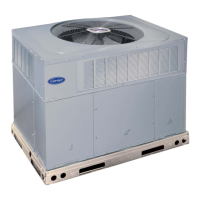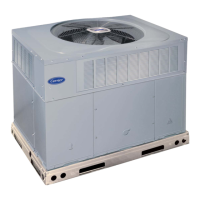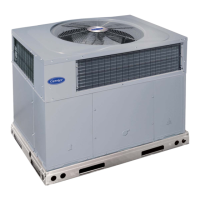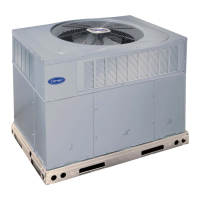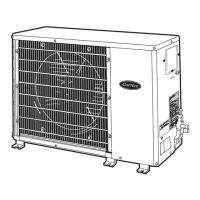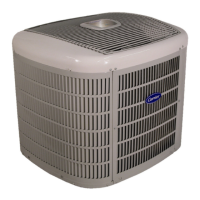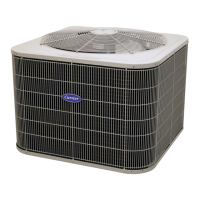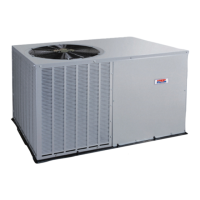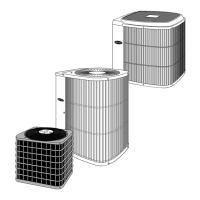50VR-K: Installation Instructions
Manufacturer reserves the right to change, at any time, specifications and designs without notice and without obligations.
30
Servicing Systems on Roofs with Synthetic Materials
POE (polyolester) compressor lubricants are known to cause long term
damage to some synthetic roofing materials. Exposure, even if
immediately cleaned up, may cause embrittlement (leading to cracking)
to occur in one year or more. When performing any service that may risk
exposure of compressor oil to the roof, take appropriate precautions to
protect roofing. Procedures which risk oil leakage include, but are not
limited to, compressor replacement, repairing refrigerant leaks, replacing
refrigerant components such as filter drier, pressure switch, metering
device, coil, accumulator, or reversing valve.
Synthetic Roof Precautionary Procedure
1. Cover extended roof working area with an impermeable
polyethylene (plastic) drip cloth or tarp. Cover an approximate 10 x
10 ft (3 x 3 m) area.
2. Cover area in front of the unit service panel with a terry cloth shop
towel to absorb lubricant spills, prevent run-offs, and protect drop
cloth from tears caused by tools or components.
3. Place terry cloth shop towel inside unit immediately under
component(s) to be serviced and prevent lubricant run-offs through
the louvered openings in the unit base.
4. Perform required service.
5. Remove and dispose of any oil contaminated material per local
codes.
Liquid Line Filter Drier
The filter drier is specifically designed to operate with Puron (R-410A).
Use only factory-authorized components. Filter drier must be replaced
whenever the refrigerant system is opened. When removing a filter drier,
use a tubing cutter to cut the drier from the system. Do not unsweat a
filter drier from the system. Heat from unsweating will release moisture
and contaminants from drier into system.
Puron (R-410A) Refrigerant Charging
Refer to unit information plate and charging chart. Some R-410A
refrigerant cylinders contain a dip tube to allow liquid refrigerant to flow
from cylinder in upright position. For cylinders equipped with a dip tube,
charge Puron (R-410A) units with cylinder in upright position and a
commercial metering device in manifold hose. Charge refrigerant into
suction-line.
Step 5 – System Information
Loss of Charge Switch
The loss of charge switch is a protective device wired into control circuit
(low voltage). It shuts off the compressor if abnormally low pressures
are present in the refrigeration circuit.
NOTE: Because these switches are attached to refrigeration system
under pressure, it is not advisable to remove this device for
troubleshooting unless you are reasonably certain that a problem exists.
If switch must be removed, remove and recover all system charge so that
pressure gauges read 0 psig. Never open system without breaking
vacuum with dry nitrogen.
Check Defrost Thermostat
The defrost thermostat is usually located on the lowest liquid leaving
circuit of the left condenser coil (see Fig. 23). The thermostat closes at
32_F (0_C) and opens at 65_F (18_C).
The defrost thermostat signals heat pump that conditions are right for
defrost or that conditions have changed to terminate defrost. It is a
thermally actuated switch clamped to outdoor coil to sense its
temperature. Normal temperature range is closed at 32_ 3_F (0
1.7_C) and open at 65_ 5_F (18 2.8_C).
NOTE: The defrost thermostat must be located on the liquid side of the
outdoor coil on the bottom circuit and as close to the coil as possible.
C99029
Fig. 23 – Defrost Thermostat
Troubleshooting
Refer to the Troubleshooting Chart (Table 11) for troubleshooting
information.
Start-up Checklist
Use the Start-Up Checklist at the back of this manual.
FEEDER TUBE
STUB TUBE
DEFROST
THERMOSTAT
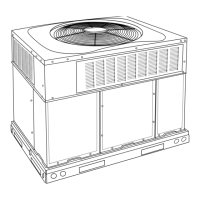
